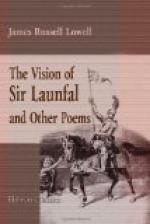45. In that new childhood of the Earth: This poem was written a few weeks after the Vision of Sir Launfal was published, and it therefore naturally partakes of its idealism.
THE PRESENT CRISIS
This poem was written in 1844. The discussion over the annexation of Texas was absorbing public attention. The anti-slavery party opposed annexation, believing that it would strengthen the slave-holding interests, and for the same reason the South was urging the scheme. Lowell wrote several very strong anti-slavery poems at this time, To W.L. Garrison, Wendell Phillips, On the Death of C.T. Torrey, and others, which attracted attention to him as a new and powerful ally of the reform party. “These poems,” says George William Curtis, “especially that on The Present Crisis, have a Tyrtaean resonance, a stately rhetorical rhythm, that make their dignity of thought, their intense feeling, and picturesque imagery, superbly effective in recitation. They sang themselves on every anti-slavery platform.”
While the poem was inspired by the political struggle of the time, which Lowell regarded as a crisis in the history of our national honor and progress, its chief strength is due to the fact that its lofty sentiment is universal in its appeal, and not applicable merely to temporal and local conditions.
17. Round the earth’s electric circle, etc.: This prophetic figure was doubtless suggested by the first telegraph line, which Samuel F.B. Morse had just erected between Baltimore and Washington.
37. The Word: “In the beginning was the Word, and the Word was with God, and the Word was God.” (John i, 1.)
44. Delphic cave: The oracle at Delphi was the most famous and authoritative among the Greeks. The priestess who voiced the answers of the god was seated in a natural fissure in the rocks.
46. Cyclops: The Cyclopes were brutish giants with one eye who lived in caverns and fed on human flesh, if the opportunity offered. Lowell is recalling in these lines the adventure of Ulysses with the Cyclops, in the ninth book of Homer’s Odyssey.
64. Credo: Latin, I believe: the first word in the Latin version of the Apostles’ Creed, hence used for creed.
THE COURTIN’
This poem first appeared as “a short fragment of a pastoral,” in the introduction to the First Series of the Biglow Papers. It is said to have been composed merely to fill a blank page, but its popularity was so great that Lowell expanded it to twice its original length, and finally printed it as a kind of introduction to the Second Series of the Biglow Papers. It first appeared, however, in its expanded form in a charitable publication, Autograph Leaves of Our Country’s Authors, reproduced in facsimile from the original manuscript.
“This bucolic idyl,” says Stedman, “is without a counterpart; no richer juice can be pressed from the wild grape of the Yankee soil.” Greenslet thinks that this poem is “perhaps the most nearly perfect of his poems.”




